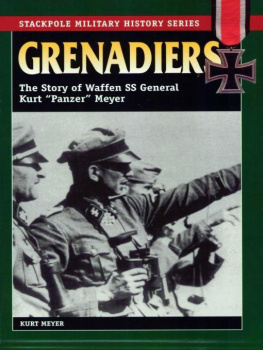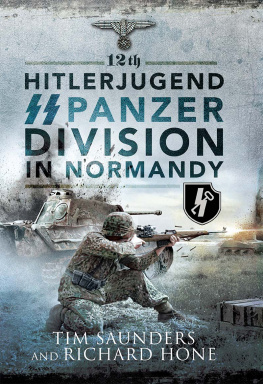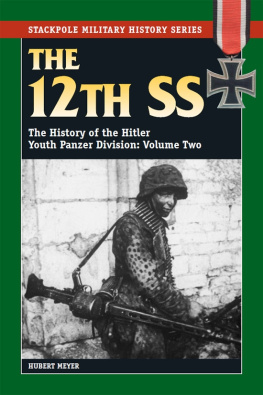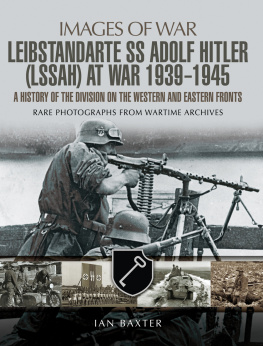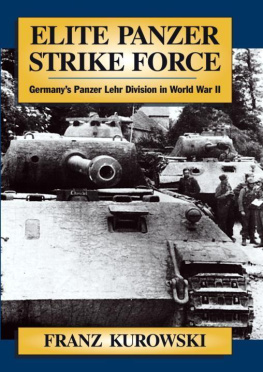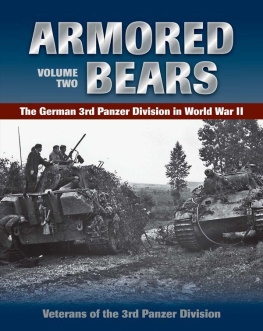Table of Contents

Copyright 1957 by Schild-Verlag, Zweibrucken, Germany English edition copyright 2001 by J. J. Fedorowicz Publishing, Inc.
Published in 2005 by
STACKPOLE BOOKS
5067 Ritter Road
Mechanicsburg, PA 17055
www.stackpolebooks.com
Originally published as GRENADIERE by Schild-Verlag
All rights reserved, including the right to reproduce this book or portions thereof in any form or by any means, electronic or mechanical, including photocopying, recording, or by any information storage and retrieval system, without permission in writing from the publisher. All inquiries should be addressed to J. J. Fedorowicz Publishing, Inc., 104 Browning Boulevard, Winnipeg, MB, R3K 0L7, Canada.
www.jjfpub.mb.ca
Printed in the United States of America
10 9 8 7 6 5 4 3 2 1
FIRST EDITION
Library of Congress Cataloging-in-Publication Data
Meyer, Kurt, 190-1961.
[Grenadiere. English]
Grenadiers: the story of Waffen SS General Kurt Panzer Meyer Kurt Meyer; translated by Michael Mend and Robert J. Edwards.
p. cm.
Includes index.
ISBN 0-8117-3197-9
1. Meyer, Kurt, 1910-1961. 2. World War, 1939-1945Personal narratives, German. 3. World War, 1939-1945Campaigns. 4. Waffen SSBiography. 5. GeneralsGermanyBiography. I. Mend, Michael. II. Edwards, Robert J. III. Title.
D81 1.M48513 2005
940.541343092dc22
2004027567
ISBN 978-0-8117-3197-3
Preface
I often fought alongside Waffen-SS formations as an armor commander; I found I could rely on them.
The 12. SS-Panzer Division Hitlerjugend mentioned in the second part of the book was under my operational control during five hard weeks on the Normandy invasion front. Its commander was the author of this book, Kurt Meyer, Generalmajor der Waffen-SS. At the end of the war we spent several months together in a camp at Enfield in England.
In December 1945 I was flown to Kurt Meyers Canadian court-martial at Aurich. I was the sole German soldier allowed to be a witness in his defense. Some of his comrades and I were also given the opportunity to be with him for a short period of time after he had been sentenced to death.
After his sentence had been commuted to life imprisonment, I got in touch with him and his wife as soon as possible. We remained friends until his far too premature death.
As a result, I knew Generalmajor der Waffen-SS Kurt Meyer and his 12. SS-Panzer-Division Hitlerjugend rather well. I knew them in good times and, even more, in the bad ones.
The book Grenadiers chronicles the fighting of the Waffen-SS units during the Second World War under the command of Panzermeyeras the author was known to his troopsin Poland, France, the Balkans, Russia, and on the Normandy invasion front. The courage, comradeship, chivalry and patriotism of the troops described are also representative of the military discipline, the selfless devotion, and performance of all other Waffen-SS Divisions and, indeed, the entire German Army.
Kurt Meyer wrote this book after his release from nine years of prison. It was important to him to memorialize through this book those soldiers of his who were still livingand who looked up to him as a father figureand to the dead of all of the divisions of the Waffen-SS and the army.
The 12. SS-Panzer Division Hitlerjugend, to which a portion of this book is dedicated, fought in Normandy for ten long weeks, mostly as the Schwerpunkt of the counterattack against Montgomerys army groups continuous assaults and massive material advantage. The division was nearly destroyed. Its performance was always more than could be expected of it. Such exceptional accomplishments would have been impossible if the soldiers had been drilled to zombie-like obedience. The young soldiers were trained to act on their own initiative, thanks to the exemplary training that had grown out of the practical experience of war. Behind all this was a love for the Fatherland.

SS-Obersturmbannfhrer Kurt Meyer in the spring of 1943. An official portrait after his award of the Oak Leaves to the Knights Cross. ROGER JAMES BENDER
The success of the 12. SS-Panzer-Division Hitlerjugend was frequently due to the personal intervention of its thirty-four-year-old commander. His analytical skills, coupled with a sixth sense for danger and his ability to make the correct decision, enabled him to intervene personally at the right place and time. His determination and personal example gave the soldiersand not only of his divisionthe strength to persevere and to counterattack. He suffered the deaths of his soldiers as if they were his sons.
Kurt Meyers courageous bearing as he stood before the victors court-martial at Aurich at the end of 1945 far exceeded mere warrior mentality, as did his composure when he listenedunjustly condemnedto his death sentence. I take my hat off to the courage then required and the chivalry of the Canadian General who did not sign this sentence but commuted it to life imprisonment. I also take my hat off to our Kurt Meyer who remained the same German officer in the death cell and in prison amongst criminals that he had been on the battlefield.
An additional heavy burden was his anxiety over his wife and five children, who had to survive just on social security benefits during his nine years in prison.
Neither during this time, nor after his release, did Kurt Meyer feel any hatred. With the help of his old comrades he soon built a new life for himself. In spite of his wounds, illness and imprisonment, he also felt obliged to support the reputation of his fallen comrades and their windows and children as well as those who survived. That is how this book came into being. Consequently, he shouldered the burden of being the first spokesman for the HIAG [Editors Note: Hilfsgemeinschaft auf Gegenseitigkeit der Angehrigen der ehemaligen Waffen-SS = Waffen-SS Mutual Aid Society].
Nine hundred thousand soldiers served in the thirty-six Waffen-SS Divisions. About four hundred thousand were killed or are missing. Of the survivors, every second one had been wounded, often several times. These numbers speak for themselves. If one adds the families, the former members of the Waffen-SS total several million German citizens. In the long run, no democracy can do without the willing participation of so many people without severe problems. They had clearly proven their willingness to sacrifice themselves for Germany. As the first spokesman for the HIAG, Kurt Meyer led his old comrades by his example and words in a deeply felt involvement in our democracy. His involvement stemmed from his former love of fatherland, coupled with the insights he had won during and after the war. He did this although the former members of the Waffen-SS and their families do not receive the same state benefits as other German combatants of World War II. Even today, Kurt Meyers widow receives no pension.
After 1945 a flood of hatred was poured on the Waffen-SS. The things that were said about this component of the German Armed Forces do not, in the main, stand up to detailed inspection. Not only foreigners, but also many of our own population, lump the soldiers of the Waffen-SS with the members of the SD and those of the Allgemeine SS. This book has also been written to set truth against libel. In this way the contribution of the Waffen-SS may be seen objectively. Furthermore, the book will show the children of the Waffen-SS soldiers their fathers deeds in an undistorted manner. They will be proud of their fathers courage, constancy, decency, and their love of the fatherland. They also will read about the terror of war.
Next page
